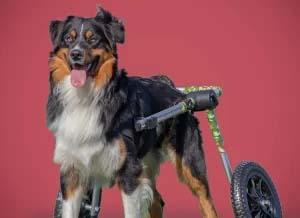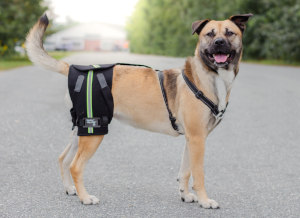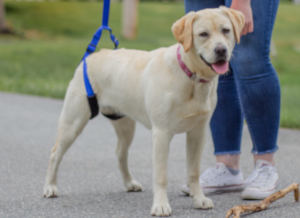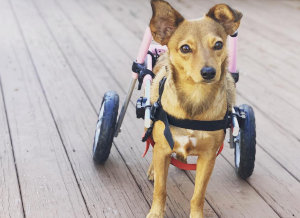
Article written by Dr. Lucy Tidd, DVM
What’s Hip Dysplasia?
Hip dysplasia is a reasonably frequent challenge for canine, particularly for bigger or extra muscular breeds equivalent to German Shepherds, Saint Bernards, Labrador Retrievers, Golden Retrievers, Outdated English Sheepdogs, and Bulldogs. The issue begins throughout puppyhood, when the thighbone and the hip socket don’t develop at equal charges, inflicting looseness within the joint and resulting in degenerative joints or osteoarthritis.
Whereas hip dysplasia is a genetic illness, a number of elements can influence its severity, equivalent to:
- Food regimen
- Setting
- Train
- Development charge
- Muscle mass
- Hormones
Some canine present signs of hip dysplasia early of their life, whereas others could not exhibit any indicators of the illness, regardless of having X-rays proving its presence. It’s crucial for canine to be fed a nutritious diet and get loads of train all through their life to cut back the problematic results of hip dysplasia.
Indicators My Canine Has Hip Dysplasia
Since hip dysplasia is sort of frequent, it’s essential which you could acknowledge the indicators early on in an effort to present the very best interventions and ache administration on your canine.
Some frequent indicators that your canine could also be creating canine hip dysplasia embody:
1. Decreased Exercise
In case your canine has turn out to be noticeably much less energetic, spends extra time resting, or reveals little enthusiasm for normal walks and actions, it could possibly be their means of managing ache. Whereas many individuals attribute their canine’s sedentary nature to growing old, it’s doable they’re affected by canine hip dysplasia.
2. Incapability to Bounce or Climb Stairs
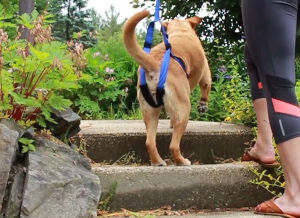
Your canine’s hind legs play an necessary position of their skill to climb stairs and leap.
When hip dysplasia happens, irritation develops, inflicting your canine to endure from a smaller vary of movement than it could in any other case have. As well as, irritation and hip ache could make utilizing the steps difficult for a canine with hip dysplasia.
3. Issue Standing Up
In case you discover that your canine is slower to rise than regular, having nice issue standing up from a mendacity place, it could possibly be resulting from ache. Offering a snug mattress or carpeted space on your canine to relaxation on will make rising a bit simpler and reduce ache extra so than more durable flooring equivalent to tile, linoleum, or wooden.
4. Modifications in Gait
That is typically referred to as “bunny-hopping” and refers to irregular adjustments in how your canine walks. It’s referred to as this as a result of canine will raise each hind legs without delay, as if leaping like a rabbit. That is thought to lower the ache they really feel of their hind legs and the quantity of weight bearing down on them.
5. Limb Numbness
In case your canine’s hip dysplasia is extreme, chances are you’ll observe lameness within the hind legs. This could possibly be intermittent or steady as the wear and tear and tear in your canine’s hip joints will increase. The ensuing irritation and ache could cause your canine to be unable to stroll on their hind legs in any respect.
6. Hip Ache and Sensitivity
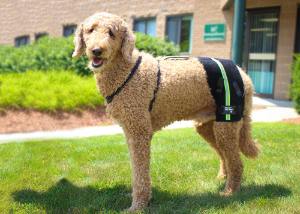
In case your canine reveals indicators of discomfort if you contact its hips, it could possibly be related to hip dysplasia. Because the shock-absorbing cartilage surrounding the hip joint and socket wears down, the pores and skin across the space grows tender to the contact.
A canine hip brace helps to alleviate canine hip ache and encourage mobility. Whereas these are some frequent signs of hip dysplasia, an X-ray out of your veterinary technician can decide the true trigger. The illness is clearly seen on X-rays, as you’ll be able to see how the thighbone and hip socket deteriorate over time.
What to Do for a Canine Displaying Indicators of Hip Dysplasia?
When caring on your furry greatest buddy, it’s by no means too early to take motion to stop painful hip dysplasia. There are 4 necessary steps you’ll be able to take to lower your canine’s probabilities of affected by this debilitating illness:
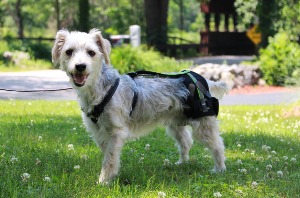
- Keep away from overfeeding your canine: Additional weight will put added strain on the hips and joints, so overfeeding is a foul concept.
- Don’t overdo it with train: Whereas train is nice for a rising canine, steering away from an excessive amount of exercise will scale back the probabilities of dysplasia setting in. Moreover, don’t let your pup play on slippery surfaces or leap from extreme heights, as this might trigger everlasting harm to the hips.
- Verify your pup’s pedigree: On the subject of pedigree, some canine breeders are extra enthusiastic about turning a revenue than doing their half to reinforce a canine’s bloodline – don’t be afraid to ask for references.
- Give your canine hip and joint dietary supplements: There are a number of high-quality dietary supplements that can serve to cut back your canine’s danger of creating hip dysplasia, the most typical substances being glucosamine and chondroitin. These will promote wholesome joints in your pup and reduce the probabilities of them creating canine hip dysplasia.
In case your canine is within the higher-risk class of canine breeds, it’s essential that you simply implement preventative care from a younger age. Defending your canine from hip dysplasia is an enormous accountability, however the payoff is a cheerful and wholesome pup that grows and thrives together with you.
Can You Forestall Hip Dysplasia in Canines?
Whereas it’s typically troublesome to evaluate whether or not your canine is genetically extra prone to develop hip dysplasia, there are some methods in which you’ll scale back the dangers. Hip dysplasia is a painful and debilitating illness, so it’s necessary to be proactive from the beginning to make sure your pup lives an extended and wholesome life. A high-quality eating regimen, joint well being dietary supplements, and sustaining a wholesome weight have confirmed to have probably the most important influence on stopping hip dysplasia.
Canines with hip dysplasia can be handled by surgical care to restore or exchange joint misalignment, however that is usually used as a final resort, as it may be costly and requires an extended restoration interval. Whereas hip dysplasia is attributable to a mixture of genetic and environmental elements, it’s your job to make sure the very best life doable on your furry greatest buddy.


Visitor Creator:
Dr. Lucy Tidd, DVM
Dr. Tidd is a veterinarian at Germantown Veterinary Clinic in Germantown, MD.
Dr. Tidd is a graduate of Cornell College (BS Animal Science) and Cornell Faculty of Veterinary Drugs. She presently sits on the Alumni Board for the latter establishment. Dr. Tidd has a particular curiosity in inner medication, and she or he enjoys difficult medical and surgical circumstances.
Associated Articles:
Did we reply all of your questions on “Hip Dysplasia”?

